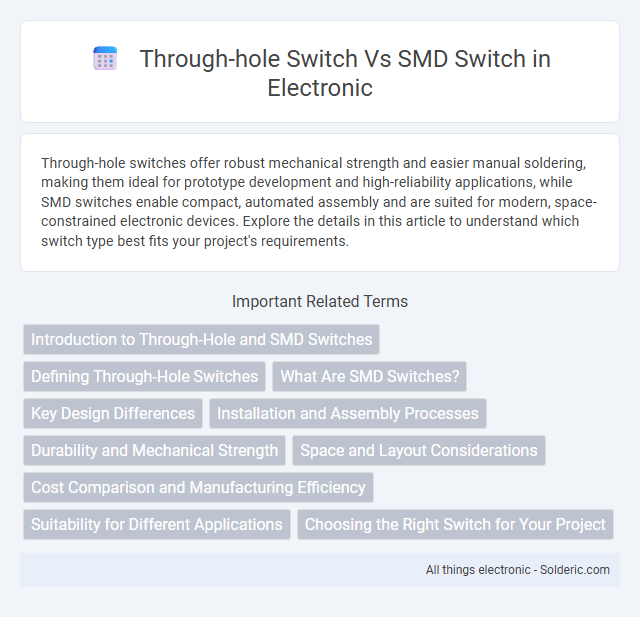Through-hole switches offer robust mechanical strength and easier manual soldering, making them ideal for prototype development and high-reliability applications, while SMD switches enable compact, automated assembly and are suited for modern, space-constrained electronic devices. Explore the details in this article to understand which switch type best fits your project's requirements.
Comparison Table
| Feature | Through-Hole Switch | SMD Switch |
|---|---|---|
| Mounting Type | Leads inserted through PCB holes | Surface-mounted directly on PCB pads |
| Size | Larger, bulky | Smaller, compact |
| Assembly Process | Manual or wave soldering | Automated pick-and-place with reflow soldering |
| Mechanical Strength | Higher mechanical stability | Lower mechanical durability |
| Repairability | Easier to replace and repair | More difficult to rework or replace |
| Cost | Higher per unit in large volume | Lower in mass production |
| Typical Applications | Prototyping, rugged designs | High-density, compact electronics |
| Common Sizes | SPST, DPDT larger switches | Micro switches, tact switches |
Introduction to Through-Hole and SMD Switches
Through-hole switches feature leads that pass through the PCB, providing strong mechanical bonds ideal for high-stress applications and prototyping. SMD switches, or surface-mount device switches, are mounted directly on the PCB surface, enabling compact designs and automated assembly processes critical for modern electronics. Your choice between through-hole and SMD switches impacts manufacturing efficiency, board space utilization, and durability in electronic device design.
Defining Through-Hole Switches
Through-hole switches feature leads that pass through PCB holes, offering strong mechanical bonds ideal for high-stress applications and prototyping. These switches provide easy manual soldering and reliable durability, making them suitable for robust electronic devices. Their larger size allows for straightforward handling but limits circuit miniaturization compared to SMD switches.
What Are SMD Switches?
SMD switches, or Surface-Mount Device switches, are compact electronic components designed for direct mounting on a printed circuit board (PCB) surface, offering space-saving advantages over traditional through-hole switches. They enable automated assembly processes and improve reliability by minimizing solder joint issues. Your choice between through-hole and SMD switches impacts device design, manufacturing efficiency, and overall performance.
Key Design Differences
Through-hole switches feature long leads designed to pass through circuit board holes for soldering, offering superior mechanical stability and ease of manual assembly. SMD switches have flat, short leads mounted directly onto the PCB surface, enabling higher component density and compatibility with automated placement equipment. The key design difference lies in their mounting approach, influencing board layout, assembly methods, and mechanical durability.
Installation and Assembly Processes
Through-hole switches require inserting component leads into drilled holes on a printed circuit board (PCB) followed by wave or manual soldering, making them well-suited for prototyping and environments demanding robust mechanical connections. SMD (Surface Mount Device) switches are mounted directly onto PCB surface pads using automated pick-and-place machines and reflow soldering, enabling higher assembly speed and greater production scalability. The choice between through-hole and SMD switches impacts the cost-efficiency of assembly lines, the precision of component placement, and the suitability for automated manufacturing processes.
Durability and Mechanical Strength
Through-hole switches offer superior durability and mechanical strength due to their robust mounting and larger physical size, making them ideal for applications where frequent mechanical stress occurs. SMD switches, while compact and suitable for high-density PCB layouts, typically have lower mechanical resilience and may wear out faster under heavy use. Your choice should consider the expected mechanical load and longevity requirements of the device.
Space and Layout Considerations
Through-hole switches require more PCB space due to their larger size and lead-based mounting, impacting your layout flexibility in compact designs. SMD switches offer a smaller footprint, allowing higher component density and more efficient use of board real estate. Choosing SMD switches enhances space optimization, especially important for modern, miniaturized electronic devices.
Cost Comparison and Manufacturing Efficiency
Through-hole switches generally incur higher costs due to increased material use and more labor-intensive assembly processes, which directly affect Your production budget. SMD switches optimize manufacturing efficiency by enabling automated pick-and-place assembly, reducing labor costs, and shortening production cycles. Cost savings from SMD technology often outweigh initial investment in surface-mount equipment, making it ideal for high-volume electronics manufacturing.
Suitability for Different Applications
Through-hole switches provide robust mechanical strength and are ideal for applications requiring frequent manual operation or high durability, such as industrial equipment and consumer electronics with heavy usage. SMD switches, being smaller and suited for automated assembly, excel in compact devices like smartphones, laptops, and other portable electronics where space-saving and production efficiency are critical. Choosing between through-hole and SMD switches depends on factors like mechanical stress, space constraints, and manufacturing processes specific to the target application.
Choosing the Right Switch for Your Project
Choosing the right switch for your project depends on factors such as PCB layout, mechanical durability, and assembly method. Through-hole switches offer robust mechanical strength and are ideal for prototypes or circuits requiring manual replacement, while SMD switches enable compact design and automated assembly suitable for high-volume production. Consider the switch's size, mounting style, and electrical specifications to match your project's technical and manufacturing requirements.
through-hole switch vs SMD switch Infographic

 solderic.com
solderic.com